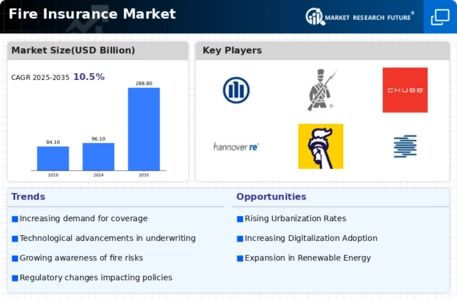Increased Urbanization
The trend of urbanization appears to be a significant driver for the Fire Insurance Market. As populations migrate towards urban centers, the density of buildings and infrastructure increases, leading to a higher risk of fire incidents. This urban growth necessitates comprehensive fire insurance coverage to protect residential and commercial properties. According to recent data, urban areas experience a higher frequency of fire-related claims, which could potentially lead to increased premiums. The Fire Insurance Market must adapt to these changing demographics by offering tailored policies that address the unique risks associated with urban living. Furthermore, the expansion of urban infrastructure, including high-rise buildings and industrial complexes, may require specialized fire insurance products to mitigate potential losses.
Rising Awareness of Fire Safety
There is a growing awareness of fire safety among consumers and businesses, which seems to be influencing the Fire Insurance Market positively. Educational campaigns and government initiatives aimed at promoting fire safety measures have led to an increase in demand for fire insurance policies. Data indicates that regions with active fire safety programs report a higher uptake of fire insurance, as individuals and organizations recognize the importance of financial protection against fire-related losses. This heightened awareness may also drive innovation within the Fire Insurance Market, prompting insurers to develop more comprehensive coverage options that include preventive measures and risk assessments. As consumers become more informed, they are likely to seek policies that not only cover damages but also incentivize fire safety practices.
Regulatory Compliance and Standards
Regulatory compliance is a critical driver for the Fire Insurance Market, as governments worldwide implement stricter fire safety regulations. These regulations often mandate that property owners maintain adequate fire insurance coverage, thereby increasing the overall demand for such policies. Compliance with fire safety standards not only protects individuals and businesses but also reduces the financial burden on insurers by minimizing the frequency and severity of claims. As regulatory frameworks evolve, the Fire Insurance Market must adapt its offerings to ensure that they meet these new requirements. This may involve developing specialized products that cater to specific industries or regions, reflecting the unique regulatory landscapes. Consequently, insurers that proactively align their policies with regulatory changes may gain a competitive edge in the market.
Economic Growth and Property Development
Economic growth is a pivotal driver for the Fire Insurance Market, as it often correlates with increased property development and investment. As economies expand, there is a surge in construction activities, leading to a higher demand for fire insurance coverage. New residential and commercial properties require adequate fire protection to safeguard against potential losses. Data suggests that regions experiencing robust economic growth also witness a rise in fire insurance premiums, as the value of insured properties increases. Additionally, the Fire Insurance Market may benefit from partnerships with developers to create tailored insurance solutions that address the specific risks associated with new constructions. This symbiotic relationship could enhance market penetration and foster long-term growth for insurers.
Technological Advancements in Risk Assessment
Technological advancements are reshaping the Fire Insurance Market by enhancing risk assessment capabilities. The integration of data analytics, artificial intelligence, and IoT devices allows insurers to evaluate fire risks more accurately and efficiently. For instance, predictive modeling can identify high-risk areas and potential hazards, enabling insurers to tailor their offerings accordingly. This technological shift may lead to more competitive pricing structures and improved customer satisfaction, as policies become more aligned with individual risk profiles. Moreover, the use of smart technology in buildings, such as fire detection systems, could potentially lower insurance premiums, as these innovations reduce the likelihood of fire incidents. The Fire Insurance Market must continue to embrace these advancements to remain relevant and responsive to evolving consumer needs.


















Leave a Comment